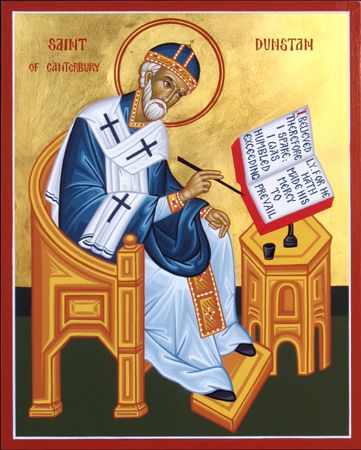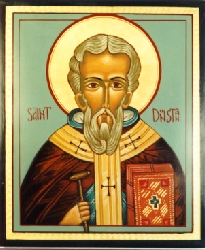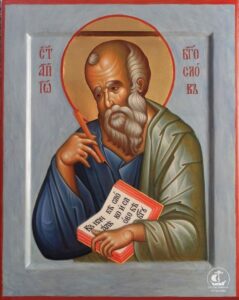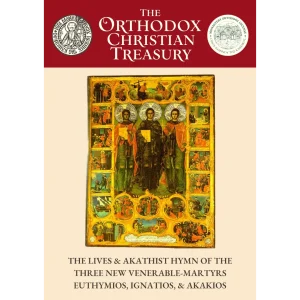SAINT DUNSTAN, ARCHBISHOP OF CANTERBURY

by Vladimir Moss
Early Years
Our holy Father Dunstan was born in the village of Baltonsborough, near Glastonbury, in about the year 909. His parents were of noble stock, and were called Herstan and Cynedritha. When the saint was still in his mother’s womb, she went to church on the Feast of the Meeting of the Lord – Candlemas, as it was known in the West. According to the custom, everyone was holding lighted candles in their hands. Suddenly all the candles went out. Equally suddenly, Cynedritha’s candle was rekindled; the amazed congregation then rekindled their candles from hers. This was taken as a sign that the child she was carrying would be a great light in the Church, from whom many others would draw enlightenment and inspiration. The saint knew Glastonbury from his earliest years. According to an ancient tradition then current, the first Christians who came to England found at Glastonbury ‘an ancient church not built by human hands and prepared by God for the salvation of men, which the Lord by many miracles showed to have been dedicated to Himself and the Most Holy Mother of God Mary’. Once the young Dunstan was taken there on a pilgrimage by his father. During the night an old man dressed in a shining white garment appeared to him in a vision, and led him through all the rooms of the holy church. He also showed him the monastery buildings which were to be built by him during his abbacy in the very order in which they were later constructed. On seeing their son’s promise, Herstan and Cynedritha sent him to Glastonbury to be educated. Like a bee, he darted through many fields of religious literature. He also learned from the Irish pilgrims who came to venerate the tomb of St. Patrick. Once he fell ill and was on the point of death. In the middle of the night, however, he received a sudden access of strength, and, springing up immediately, went with God’s guidance towards the monastery. Some dogs rushed at him, barking furiously; but he repulsed them with a thin twig and carried on. Having arrived at the church, he climbed onto the roof by a route that the workmen used, and, descending down the other side, came to a little chamber, where he innocently fell asleep. There he was found the next morning, to the amazement of everyone. For he had been at the point of death, as his nurse witnessed, and the chamber where he fell asleep was very difficult to get to. The nurse was especially amazed, and went up onto the roof to take a look round. Besides his religious activities, Dunstan cultivated the arts of metalworking, painting and harp-playing. One day, he was invited to the house of a certain noblewoman called Ethelwynn. She had asked him to design a stole to be used in the Divine services which she would then adorn with gold and silver and precious stones. Dunstan came, bringing his harp with him. Then, as they were returning to work after supper, the harp, which was hanging on the wall far from the reach of any visible hand, spontaneously began to play the melody of the hymn: ‘Let the souls of the saints who have followed in the footsteps of Christ rejoice in the heavens. Since they have shed their blood for His love, they will reign with Christ forever!’ Everyone was amazed at the miracle, wondering what it could mean. In 923, Archbishop Plegmund of Canterbury reposed in the Lord, and was succeeded by Dunstan’s uncle, Athelm, Bishop of Wells. Athelm invited the saint to stay with him at Canterbury in the archbishop’s house, and Dunstan accepted. Archbishop Athelm foresaw the future greatness of his nephew and introduced him to King Athelstan, who showed him great favour. But then a temptation was allowed to try him. Certain companions and relatives of his at the court became jealous of Dunstan’s success and accused him to the king of practising black magic. The soldier of Christ did not falter, but remembered the words of David: ‘Unjust witnesses are risen up against me, and injustice hath lied to itself’. He placed before his spiritual eyes the promise of Christ: ‘Blessed are ye when men shall revile you and persecute you and say all manner of evil against you falsely for My sake. Rejoice and be exceedingly glad; for great is your reward in heaven.’ And so, comforted by these words, he ‘became as a deaf man in whose mouth are no reproofs’; for when the dogs barked at him he hardly ever opened his mouth. But their madness grew more frenzied, and, binding him like a sheep by the arms and legs, they threw him into a muddy pool and trampled on him. He got up and set off for a friend’s house which was about a mile away. But then the friend’s dogs ran keenly up to him, and, thinking him to be more a monster than a man, started barking at him savagely. However, they soon recognized his soothing voice and calmed down. Sighing deeply, the servant of God reflected how the irrational nature of animals showed him more kindness than the animal ferocity of his kinsmen. Shortly after this, the saint went to stay with another relative of his, St. Alphege ‘the Bald’, Bishop of Winchester. Once the holy bishop was going with Dunstan to the dedication of a church at the west gate of the city. After the festivities, when they were returning past the church of St. Gregory, the bishop called a halt for Compline. As they were putting their heads together for the absolution, a stone suddenly fell out of the empty sky and passed between them, injuring no one but grazing their heads. Where could this have come from, people reflected, if not from the evil one? St. Alphege several times asked Dunstan to become a monk. But he refused, pleading that he wanted to marry. Then the bishop prayed to the Lord that the young man would pay heed to his warnings. Immediately Dunstan was seized by an intolerable pain in his bladder which passed to his whole body. Thinking that he had elephantiasis and that he was on the point of death, in great anguish he sent for the holy bishop whom he had just spurned. When the bishop arrived, he announced to him his intention of following his salutary advice. Chastened, and now recovered from his illness, Dunstan received the monastic tonsure. St. Alphege also ordained him to the priesthood, and then sent him back to Glastonbury. There he built for himself a very narrow cell in which to fast and pray. He also occupied himself in making church bells and other ecclesiastical ornaments. Now there died a close friend of the saint’s, a deacon by the name of Wulfred. Not long after his repose, Wulfred appeared to Dunstan and revealed to him many heavenly mysteries, as well as the whole course of his future life. When Dunstan asked for a sign whereby he could be assured of the truth of these revelations, Wulfred led him to the cemetery, and, pointing to an unused plot, said: ‘You will know that what I say is true from the fact that in three days’ time a priest will be buried here, although he has not yet fallen ill.’ On awaking, Dunstan related the prophecy to some others; and as they were coming back from the cemetery the chaplain of a certain very religious noblewoman came up and asked for that plot for his burial. Shortly after, he sickened and died; and within three days he had been buried in that very spot. Now there was a very rich woman of royal birth and strictly religious upbringing called Ethelfleda. On the death of her husband, wishing to live a widow’s life in accordance with her strength, she bought a small house near the church so as to be able to serve the Lord day and night. Dunstan loved her very much; and she diligently supported him for Christ’s, as well as for kinship’s, sake. Among other good works, she was much given to hospitality; and on one occasion she prepared a meal for King Athelstan, who was coming to Glastonbury to pray. The day before his visit, the king’s stewards came to see that everything was suitably prepared, and remarked that there was not enough mead. She replied: ‘My mistress, the Most Holy Mother of God, will not let me go short, either in mead or in anything else pertaining to the royal dignity.’ After saying this, she entered the Old Church, and, prostrating herself, prayed to the King of all that He would grant her an abundance of provisions for the service of the king. The king duly arrived with a large company in attendance. After the Divine Liturgy, he joyfully came to his invited seat. The supply of mead was exhausted at the first toast, but God abundantly made up the deficiency so that nothing was lacking for the whole day. However, when the king’s servants told him of the miracle, he abruptly stopped and said to his men: ‘We have sinned by over-burdening this handmaid of God with our unnecessarily large numbers.’ And getting to his feet, he bade farewell to her and continued on his way. Now Ethelfleda fell seriously ill, and the saint prepared her for her end, looking after her as if she were his own mother. Because of this, he was late for Vespers one day, and at dusk came back to the church to celebrate the delayed service. As he was standing outside the church chanting psalms with the brethren, he saw coming from the direction of the setting sun a white dove of extraordinary beauty with wing-tips sparkling like fire that entered the house of Ethelfleda. After the service, the saint went back to the house. Standing by the curtain at the entrance to her bedroom, he could hear her having a serious conversation with what seemed to be an intimate friend; and, wondering who it might be, he asked her maidservants who were standing by. They replied that they did not know. ‘Before you came,’ they said, ‘the chamber was filled with a reddish light of extraordinary splendour. That has stopped, but she, as you can hear, has not ceased from carrying on a conversation with her interlocutor.’ Dunstan sat down until she had finished her conversation. Then, drawing back the curtain, he entered her room and asked her with whom she had been speaking. ‘You yourself saw him coming before you came here,’ she said, ‘and do you ask me now with whom I have been speaking? For he who spoke with me is the same person who appeared to you as you were chanting psalms outside the church. And he told me in private everything concerning my departure from this life. But there is no need for you and your friends to weep for me – God will graciously visit me at my death and allow me to enter into the joys of Paradise. However, I want you to do this for me as if I were your only friend: hasten early in the morning, prepare a funeral vestment for me to wear, make ready a bath, and after my bath celebrate the Divine Liturgy, communicating me in the Holy Body and Blood of our Lord Jesus Christ. At that moment, with God leading me, I shall go the way of all the earth.’ Dunstan promptly obeyed the blessed lady’s commands to the last detail. And after partaking of the Holy Mysteries, just as the Liturgy was coming to an end, Ethelfleda gave up her soul into the hands of her Creator. In 939, King Athelstan died, and was succeeded on the throne of England by King Edmund. Dunstan became one of his counsellors, for his court at Cheddar was not far from Glastonbury. As in Athelstan’s reign, this provoked the envy of some of the courtiers, who slandered the saint to the king and procured his banishment. Dunstan then asked the help of some foreign envoys who were then at court, and they, taking pity on him, promised him their hospitality and everything he might need if he accompanied them back to their kingdom. The next day the king rode out hunting with his men. As they came to the forest, they dispersed in friendly competition along different paths. However, the baying of the dogs and the calling of the horns enabled many of the stags to make a quick escape; and only the king, with one pack of dogs, found himself on the track of a stag. In his flight the exhausted animal came to a very deep gorge into which he suddenly hurled himself, followed by the dogs. The king, following close behind, was accelerating when he saw the gorge. Desperately he tried hold back his horse, but without success. With all hope for his life gone, he commended his soul into the hands of God, saying within himself: ‘I thank Thee, O God Most High, that as far as I can remember, I have not harmed anyone at this time, except only Dunstan, and I shall be reconciled with him promptly if my life is saved.’ When he had said this, his horse came to a standstill on the very edge of the abyss. Praising and giving thanks to God, the king realized that he had come so near to being killed in order that Dunstan might be vindicated; and on his return he ordered him to be brought before him without delay. When Dunstan came in, he said: ‘Hurry up, get a horse, and come with me and my soldiers.’ And, mounting their horses, they immediately took the road to Glastonbury. On arrival, they went into the church to pray; and after praying and wiping the tears from his eyes, the king again called the servant of God to him. Taking him by the hand, he kissed it and led him to the priest’s chair. Having seated him in it, he said: ‘Be the powerful incumbent of this seat and the most faithful abbot of this church. And whatever you need, whether for the Divine services or for the sacred Rule, I shall devoutly supply from my royal bounty.’
Abbot of Glastonbury Dunstan was placed in charge of the monastery at Glastonbury in the year 943, and immediately instituted the strict application of St. Benedict’s Rule for the monks, thus giving a major impetus to the revival of monasticism in England after the devastation of the Viking wars. He also began to build many new buildings for the monastery in accordance with his childhood vision. One day, a great beam was being passed to the roof of the church, and was about to touch it when it began to tilt downwards and fall, threatening the lives of many people below. A cry went up, and the saint’s eyes were drawn to the scene. With his right hand he made the sign of the Cross, and lo! By the invisible power of God the beam was restored to its place. Enraged by these miracles, which were drawing the souls of their beholders closer to the Lord, Satan tempted the saint by appearing to him in many fearful guises. One night, as he was keeping vigil at the altar of St. George and resting a little, the devil came up behind him in the form of a bear, threatening to devour him. At first the man of God tried to beat him with a staff which he always carried with him; but to no avail. Then he resorted to the stronger spiritual weapon of psalmody: ‘Let God arise, and let His enemies be scattered, and let them that hate Him flee from before His face’. The deceiver fled in confusion… Through another vision of evil spirits, the saint prophesied the death of King Edmund. For as he was travelling in the king’s escort, he suddenly saw a black form running among the king’s trumpeters. After gazing at it for a long time in amazement, he turned to his neighbour, ‘Half-King’ Athelstan, the alderman of East Anglia, and said: ‘Beloved, do you see what I see?’ ‘Nothing out of the ordinary,’ he replied. ‘Sign yourself with the sign of the Holy Cross, and then see if you can see what I see,’ said the holy man. When he did this, Athelstan also saw the evil spirit. When they made the sign of the Cross again, the enemy disappeared. As they continued on their way, Athelstan asked the saint to what extent this vision of theirs was related to a dream he had had, in which he had seen the king fall asleep while feasting among his nobles, whereupon almost all the chief men and counsellors had turned into sheep and goats. Dunstan immediately replied: ‘The king’s sleep means his death; but the changing of the chief men and counsellors into mute and irrational beasts refers to the future, when almost all the chief men and rulers will of their own accord deviate from the way of truth.’ As they came to the king’s quarters, they were still discussing these matters. And at dusk on the same day Dunstan again saw the evil spirit wandering among the servants at the king’s banquet. Then, on the very day on which the king was killed, May 26, 946, he saw it for the third time as the king was returning from the Divine Liturgy to the banquet-hall. During the feast, the king saw a man named Liofa, whom he had banished from the kingdom six years before, sitting at a table next to an alderman. He got up and tried to drive the outlaw from the hall, but was stabbed by him and died. The king’s body was taken to Glastonbury, where St. Dunstan performed the funeral service. Edmund was succeeded by his brother Edred, who loved Dunstan no less than his predecessors, loading him with honours and submitting to his wise counsel. In 953, Bishop Ethelgar of Crediton died; whereupon King Edred tried to persuade the saint to accept the vacant see. But he refused, not wishing to desert the king, whom he loved, for the sake of the episcopate. The king then asked his mother, St. Elgiva, who was abbess of Shaftesbury, to intercede. So she invited him to a royal banquet and again put forward the same proposal. But he replied: ‘I ask you, lady, not to ask me this again; for I tell you truly: I must not be made a bishop during the lifetime of your son the king.’ The Lord, however, was not pleased by Dunstan’s refusal, as was revealed to him in a vision that night. For he saw himself returning from a pilgrimage to the apostles’ tombs in Rome and was coming near the Mons Gaudium. Then St. Peter and his fellow apostles Paul and Andrew approached him. Each held in his hand a sword, which they offered him. On Peter’s sword were inscribed the words: ‘In the beginning was the Word, and the Word was with God, and the Word was God.’ Then Andrew sang sweetly from the Gospel: ‘Take My yoke upon you, for I am meek and lowly of heart, and ye shall find rest unto your souls.’ Peter then raised a staff which he held in his hand and struck Dunstan lightly on the palm, saying: ‘Take this as a warning not to refuse the yoke of the Lord in future.’ Waking up, the saint asked a monk who was sleeping in the same room who it was that had struck him. He said that he did not know. Dunstan thought for a while, and then said: ‘Now I know, my son, now I know by whom I have been struck.’ In the morning he recounted his vision to the king, who said: ‘Since the swords you took up with the apostles’ blessing are the weapons of the Holy Spirit, you can be quite certain that through the sword given you by the blessed Peter and inscribed with the word of God, you are to receive the archbishopric from heaven.’ As for the other swords, that given by St. Paul may have signified the see of London, whose cathedral church was dedicated to the apostle and which Dunstan held for a short period before he became archbishop. And that of St. Andrew may have signified the see of Rochester, whose church was dedicated to the First-Called and which Dunstan was called upon to defend in his later years. King Edred had been chronically sick throughout his reign, and now he came to die. Feeling his end draw near, he sent a messenger to Dunstan to bring his treasures from Glastonbury, where the saint had been looking after them, to Frome, where the king lay. As Dunstan was riding to Frome, on St. Clement’s day, 955, he suddenly heard a voice from heaven: ‘King Edred now rests in peace.’ At the sound of the voice, his horse, unable to bear the angelic power, fell dead to the ground, astonishing the saint’s companions. When he had explained to them the voice and its meaning, and as they were blessing God and commending the soul of the dead man into the hands of God, messengers came up and confirmed the truth of the voice. And so the walls of the palace were resounding to cries of lamentation as the saint entered. He found the royal corpse abandoned; and so, faithful in death as in life, he performed the funeral service and buried the king in the Old Minster, Winchester. The death of King Edred marked the end of the peaceful part of St. Dunstan’s tenure of the Glastonbury abbacy. For he was succeeded by Edwig (Edwy), the son of King Edmund – a rash youth under the influence of a mother and daughter, both named Elgiva, who wanted him to choose one of them to be his wife. This wanton behaviour of the king was to bring him into conflict with the saint… Now the time came for the anointing and consecration of the new king after his election by the people. The ceremony was duly performed, but then the king had no time to attend the banquet with his nobles and bishops, but immediately ran after the loose women. When the holy Archbishop Oda saw that the king’s wilfulness on the day of his coronation displeased all the counsellors sitting around, he said to his fellow-bishops and the other leading men: ‘Let some of you, pray, go and fetch the king, so that he may, as is fitting, be a pleasant companion to his followers at the royal banquet.’ But one by one, fearing to incur the king’s wrath or the women’s complaint, they began to demur. Finally, they chose from among them two whom they knew to be strong in spirit – Abbot Dunstan and Bishop Cynesige, a kinsman of Dunstan’s, to go in obedience to the command of all and bring back the king, whether he wished it or not. Entering the king’s chamber in accordance with their superiors’ command, Dunstan and Cynesige found the king’s crown, which was bound with gold, silver and precious stones, and shone with a many-coloured light, carelessly thrown on the floor far away from his head, while the king himself wallowed between the two women as if he were in a pig-sty. They said to him: ‘Our nobles have sent us to you to ask you to come as quickly as possible to your proper seat, and not to scorn to be present at the joyful banquet of your chief men.’ But when the king did not want to rise, Dunstan, after first rebuking the folly of the women, drew him by his hand from his licentious reclining with them, replaced the crown on his head, and brought him with him to the royal assembly by force. Like Jezabel of old, the elder Elgiva now conceived a violent hatred for Dunstan and obtained the consent of the king to deprive him of all his honours and possessions, and to expel him from the kingdom. Dunstan’s friends and supporters were also persecuted. Elgiva even sent secret agents to kill Dunstan before he could leave the country. But he eluded her grasp, and made a speedy passage to the continent. There he was kindly received by Count Arnulf of Flanders, staying in the Abbey of St. Peter in Ghent. The saint did not cease to weep and groan day and night, thinking of his country and the spiritual condition of his monastery. One night, he dreamed that he was with a group of brethren as they were coming to the end of the Vespers psalms. After the canticle, ‘My soul doth magnify the Lord’, they began to sing the antiphon from Job: ‘Why have ye disparaged his truthful words, and composed speeches to reprove him, and…’ At this point the chant stopped and they all fell silent; nor was he able to persuade them to complete either the words or the melody. Several times they went back to the same point in the chant, never did they say the last words. And he, rebuking them in the same vision, said: ‘Why do you not want to end the antiphon with the words: “what ye have had in mind ye discharge”?’ Then came the Divine reply: ‘Because, I say, they will never discharge what they are striving for in their minds – to tear you away from the government of this monastery.’ Waking up, the saint gave thanks to God the Most High, his Comforter. And indeed, some of the people in the vision turned out later to have been plotting against him in secret. King Edwig married the younger Elgiva, although the union was within the forbidden degrees of kinship. As a result, the northern parts of the English kingdom, Mercia and Northumbria, rebelled against him, and chose his brother Edgar as their king. And in the next year Archbishop Oda dissolved his marriage. When Elgiva tried to rejoin the king, she was caught by men from the north; they severed the muscles and sinews of her lower limbs, and she died in agony a few days later. Finally, Edwig died, and when Edgar reunited the kingdom under his sole rule, he recalled Dunstan from exile…
Archbishop of Canterbury

In the year 958 King Edgar ‘the Peaceable’ ascended the throne. In the same year St. Dunstan was made Bishop of Worcester. Then, in 959, he was transferred to the see of London. And in 960 he was elected Archbishop of Canterbury. The truly ‘symphonic’ cooperation of King Edgar and Archbishop Dunstan laid the foundation of a golden age in the history of the Anglo-Saxon Church. This age had been prophesied by a heavenly voice which St. Dunstan had heard in 943, at the birth of Edgar: ‘Peace to England as long as this child reigns, and our Dunstan survives.’ ‘The succession of events,’ wrote William of Malmesbury, ‘was in unison with the heavenly oracle; to such an extent did ecclesiastical glory flourish and martial clamour decay while he was alive.’ However, the early part of Edgar’s reign was marred by his attempts to seduce two nuns of Wilton, St. Wulfhilda and Wulfrida, by the second of whom he had a daughter, St. Edith. For this he was placed on a penance by St. Dunstan, and was not allowed to wear his crown from his sixteenth to his thirtieth year. He accepted this penance humbly, and it is probably for this reason that his coronation did not take place until the year 973, in a ceremony in Bath Abbey which became the model for all future English coronations. After Dunstan had been elected archbishop, he set off, like all English archbishops-elect, for Rome, to receive the pallium (omophorion) from the Pope. On the road he gave away all his provisions to the poor, which greatly irritated his servant. So when he asked him one day: ‘What do you have to sustain us tonight?’, the servant replied: ‘Absolutely nothing; for you have taken no care about it – you have given everything away, either to our own men or to strangers.’ Then the bishop said: ‘I ask you not to be too worried by this; for Christ our Lord is bountiful to all those who believe in Him.’ But the steward replied again: ‘Now you will see what your Christ will give you tonight – you who have squandered everything.’ And he continued scoffing as the saint went in search of a place to serve Vespers. His scoffing soon ceased, however, when they were met by messengers of an abbot who had been waiting for them for three days, and who now most charitably supplied the needs of the saint and his men for many days ahead. On returning from Rome, Dunstan immediately set about spreading the monastic reforms which he had initiated at Glastonbury; and he found the king a willing helper in this holy task. Already, as Bishop of London, he had founded a small monastery of twelve monks at Westminster with St. Wulsin as abbot. Now he appointed his disciples Saints Oswald and Ethelwold, both zealous monks, to the sees of Worcester and Winchester respectively; and under their vigorous leadership the south of England was soon covered with Benedictine monasteries. The saint cared for the people as a father for his children. One practical measure he introduced was to order gold or silver pegs to be fastened to the drinking jugs in taverns. This reminded people not to drink more than the just measure and greatly reduced drunkenness and quarrels. He could be strict, too, when the occasion demanded it. Once three false coiners were caught and sentenced to have their hands cut off. On that day, which was the Feast of Pentecost, the saint was going to celebrate the Divine Liturgy; but he waited, asking whether the sentence on the coiners had been carried out. The reply came that the sentence had been deferred to another day out of respect for the feast. Then the saint said: ‘I shall on no account go to the altar today until they have suffered the appointed penalty; for I am concerned in this matter.’ For the criminals were in his jurisdiction. As he spoke, tears gushed down his cheeks, witnessing to his love for the condemned men. But when they had been punished, he washed his face and went up to the altar, saying: ‘Now I am confident that the Almighty will accept the Sacrifice from my hands.’ Once the saint was rapt up to Heaven in a vision, and saw his mother being married to a great king amidst the joyful chanting of the heavenly hosts. After this had continued for some time, one of the chanters, a young man clothed in a shining white garment, came up to Dunstan and said: ‘How is it that you see and hear this multitude glorifying the great King, while you, who ought to be especially joyful at the marriage of your mother, remain silent?’ Dunstan replied that he did not know the chants that were being sung, nor did he know how he could glorify the King. The young man said: ‘Do you wish me to instruct you how to chant?’ When Dunstan humbly replied that he did, the young man taught him the antiphon: ‘O King and Lord of all nations, for the sake of the throne of Thy majesty grant unto us the forgiveness of our sins, O Christ our King. Alleluia.’ This antiphon was repeated several times in the vision until it was firmly established in the saint’s memory. And immediately he awoke he ordered a monk to write down what he had so recently learned. Then he commanded all those in obedience to him, both monks and clergy, to learn it. Thus did the saint learn to glorify with chants and spiritual songs the marriage between Christ and His Mother, the Holy Church. On another occasion the king asked the saint to postpone the beginning of the Divine Liturgy until he had returned from hunting. The third hour was approaching, and the man of God was standing clad in his hierarchical garments, immersed in tearful prayer. Suddenly he fell into a light slumber and was rapt up to Heaven, where he heard the angels singing; ‘Kyrie eleison, Christe eleison, Kyrie eleison.’ Coming to himself, he asked whether the king had arrived. The answer was that he had not. Again he prayed, and again he was rapt up to Heaven, where he heard the last words of the Liturgy being pronounced in a high voice. At that moment some clergy ran up to him and told him that the king had arrived. But he replied that he had already been present at the Liturgy, and would not be present at or celebrate it again that day. On being asked why, he revealed to them his vision, after which he forbade the king to hunt again on the Lord’s Day. Then he taught the clergy the ‘Kyrie eleison’ which he had heard in the heavens. Once a nobleman entered into an uncanonical marriage. When he refused to renounce it, Dunstan excommunicated him. The nobleman then went to Rome, where he obtained from the Pope a written order to the archbishop compelling him to allow the marriage. But Dunstan, as his name (‘firm rock’) implied, was firm as a rock: ‘I am not to be moved,’ he said, ‘even by the threat of death, from the authority of my Lord.’ In this way the saint demonstrated his truly Orthodox consciousness and freedom from the papist heresy that sought to place the Pope’s authority above that of the Universal Church. Nor did the king try to persuade him to disobey the King of kings and Lord of lords, Jesus Christ. And so the nobleman came to repentance, and appeared before Dunstan barefoot and with a candle in his hand; whereupon he was released from his ban. Now in the capital city of Winchester opposition arose against the monastic reforms which St. Ethelwold, backed by St. Dunstan, was introducing. The secular clergy decided to refer the matter to the king, who in turn referred it to the saint. Dunstan then asked the king to convene a council in Winchester, which met in the refectory of the Old Minster in the presence of the king and queen, the nobles, monks and clergy. The final decision was announced by St. Dunstan: ‘This Old Minster was founded as a habitation for monks. Let those who benefit from its revenues henceforth live as true monks.’ It is said that during the council, when the possibility of restoring the secular clergy to the Old Minster was being discussed, a cross spoke fro the wall: ‘Far be it from you! You have done well: to change again would be wrong.’ However, the secular party did not leave it at that. When King Edgar died in 975, and the throne passed to his young son Edward, a great storm arose against the monks in many parts of the country, and the secular clergy who had been expelled from the Old Minster used the council convened at Calne in 977 to renew their complaint. But Dunstan was not to be moved. ‘Since, in my old age,’ he said, ‘you exert yourselves in the stirring up of old quarrels, I confess that I refuse to give in, but commit the cause of His Church to Christ the Judge.’ His words were confirmed by God’s verdict. For as he spoke the house was suddenly shaken; the floor of the upper room in which they were assembly fell under their feet; and the enemies of the Church were thrown to the ground and crushed by the falling timber. Only the beam on which the saint was sitting did not move. The climax of the troubles came with the murder of King Edward in 979. St. Dunstan was greatly saddened by the death of his beloved spiritual son, and, at the coronation of his half-brother, Ethelred, at Kingston, he prophesied great sorrow for the English people in the coming reign. (The stone upon which the anointing took place still exists, in the middle of Kingston.) The prophecy was exactly fulfilled after the death of the saint. Further sorrows awaited him. In 984, St. Ethelwold and the Bishop of Rochester came to visit him in Canterbury. He received them with great joy; but when they were about to return to their sees, he burst into tears, and his weeping was so intense that he could hardly speak. The bishops were terrified by this unusual behaviour and asked him the reason. After a pause he replied: ‘I weep because I know that you will soon die.’ ‘Don’t prophesy such terrible things, most holy Father,’ they said, ‘for we shall not die, but shall see each other safe and sound another time.’ But Dunstan confirmed his previous words, saying: ‘What I have said will come to pass; for you will die to this world but live to God. Nor must you remain any longer in this life, but you will go to God to reign with Him forever.’ The bishops returned to their sees, sobered by a pious fear of God. Within a few days they both reposed in peace. As archbishop, Dunstan continued to care for the western monasteries which he had founded or restored. Once he came to the monastery at Bath, where he was charitably received by the brethren. After lunch, he was rapt up in a vision and saw one of the pupils of the nearby Glastonbury school being borne away into the heavens amidst a great host of the heavenly citizens. The next day, a certain Ceolwy came from Glastonbury to ask his blessing and seek his advice on certain problems to do with the monastery and the brethren. When the saint had given him his blessing, he asked him kindly whether everything was well with the brethren. Ceolwy replied that everything was well, completely forgetting about the boy’s death. But Dunstan gently said: ‘I do not suppose that everything could be well for all of you if someone has died.’ Then Ceolwy replied: ‘Everything is well indeed, except that one of our boys died yesterday at noon.’ ‘That is what I was saying,’ said the archbishop. ‘May his spirit rest in peace in accordance with the vision we have been granted.’ On another occasion he was staying at Glastonbury and walking with a certain monk called Elfsige near the western gates of the Old Church. Suddenly he heard a voice from heaven saying: ‘Come, Elfsige, come.’ Then, turning to the monk, he said: ‘Hurry, prepare yourself, brother; for today you have been called by the Lord to leave this world and go to Him.’ The prophecy was fulfilled a few days later. The saint was constant in prayer and vigil, and when dawn broke he would often be seen applying himself to the correction of errors in manuscripts. During the day, he would give judgement between man and man, or resolve quarrels, or support widows, orphans and strangers in their necessities. He loved to tell stories from the lives of the saints (the martyrdom of St. Edmund was a particular favourite of his), speaking in both Latin and English. Everyone, including visitors from abroad, was enriched by his holy counsel. And during the Divine Liturgy he would pray with eyes and hands directed to Heaven and tears streaming down his cheeks.
Repose and Miracles But now it came for the man of God to go the way of all flesh. On the eve of the Feast of the Ascension, 988, a priest of the saint’s monastic family at Canterbury, the future Bishop of Elmham, Elfgar ‘the Almsgiver’, had the following vision. Dunstan was sitting on his Episcopal throne, dictating canon law to a scribe. While he was intent on these things, a great host of heavenly beings was seen entering the church through all the entrances. They surrounded the bishop with their festal array and cried: ‘Rejoice, our Dunstan! If you are ready, come, join our fellowship as a most honoured member!’ But he said: ‘You know, holy spirits, that I must preach to the assembled people in the mother church and communicate them in the Holy Mysteries of the Lord. So I cannot possibly come.’ To which they replied: ‘Be ready to come to us on the Sabbath.’ On the Feast of the Ascension, the saint preached three sermons whose power and glow was wonderful. Then, having said farewell for the last time to his cathedral family, he suddenly felt weak and retired to his bed. And on the morning of the Sabbath, May 19, 988, when the Mattins hymns were finished, he told the brethren to come to him. In their presence he commended his spirit to God and received the Holy Mysteries, which had been celebrated on the holy table in his presence. Then, giving thanks to God, he began to chant the words of David: ‘He made a remembrance of His wondrous deeds; merciful and compassionate is the Lord; He hath given food to them that fear Him.’ With these words he rested in peace. St. Dunstan was buried with great honour in Christchurch, Canterbury. In 1029 he was canonized by a council of bishops in Winchester. Very soon, miracles were being wrought at his tomb. A woman who had been blind for many years was healed after watching and praying at his tomb. A priest was cured of paralysis at his tomb. But a little later, while he was celebrating and giving thanks to God and St. Dunstan, he said: ‘And if there had been no Dunstan, I should still have been cured.’ Immediately he was struck with his former paralysis, and died soon after. A boy who had been dumb and lame from his birth was cured at the tomb of the saint. ‘Glory to God in the highest. Alleluia’ were his first words, and he continued to extol the miracle for the rest of his life. A girl who had been blind from her birth was brought to the tomb of the saint by her mother. When her eyes were opened she leapt for joy and said: ‘Mother, what are these beautiful things which I see?’ ‘Do you see something, my darling?’ asked the mother. ‘A beautiful man commanded me to see these beautiful things,’ she said. A certain German named Clement had been excommunicated for certain sins, and had been dragged from place to place for seven years, possessed by a demon. Coming to the tomb of the saint, he attended the all-night vigil. At the response, ‘You see a miracle,’ he leapt up and vomited the demon out together with some blood. In the year 1012, a controversy arose between the communities of Canterbury and Glastonbury as to which of them possessed the bones of the saint. The argument was finally settled in 1508, when Archbishop Wareham found the saint’s coffin at Canterbury with the inscription: ‘Here rests St. Dunstan’. The holy relics were found wrapped in linen and with a very fragrant odour, as of balsam, which testified to the heavenly glory of which the saint had been counted worthy. St. Dunstan is commemorated on May 19. Holy Father Dunstan, pray to God for us! (Sources: W. Stubbs, Memorials of St. Dunstan, Rolls series, 1874, containing the earliest “Vita Dunstani” by Saxon priest B. (c. 1000) and the eleventh-century Lives by Abelard, Osbert and Edmer; William of Malmesbury, Gesta Regum Anglorum and Gesta Pontificum Anglorum and De Antiquitate Glastoniae Ecclesiae, 2; Eleanor Duckett, Saint Dunstan of Canterbury, London: Collins, 1955; David Farmer, The Oxford Dictionary of Saints, Oxford: The Clarendon Press, 1978, p. 112; Christopher Brooks, The Saxon and Norman Kings, London: Fontana, 1963, pp. 127-128; Andrew Prescott, The Benedictional of St. Aethelwold, London: The British Library, 2002, p. 3; Hieromonk Makarios, The Synaxarion, vol. 5: May-June, Ormylia, 2005, p. 216)






